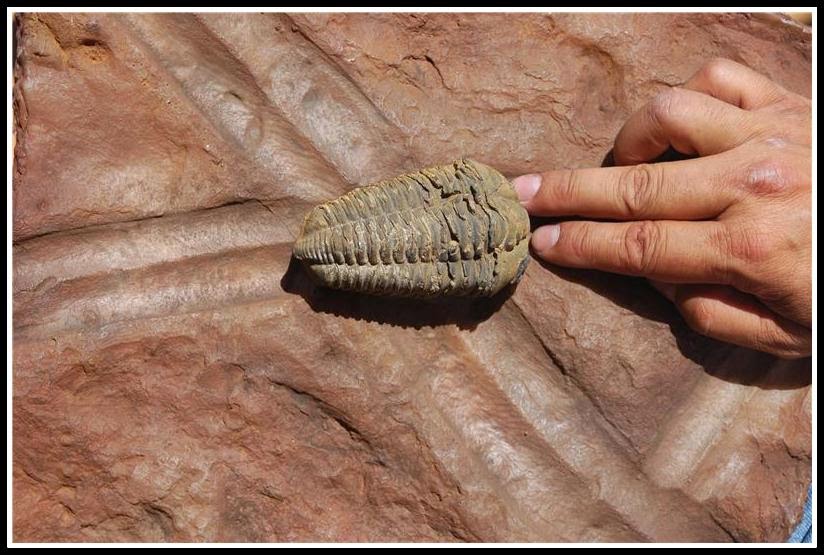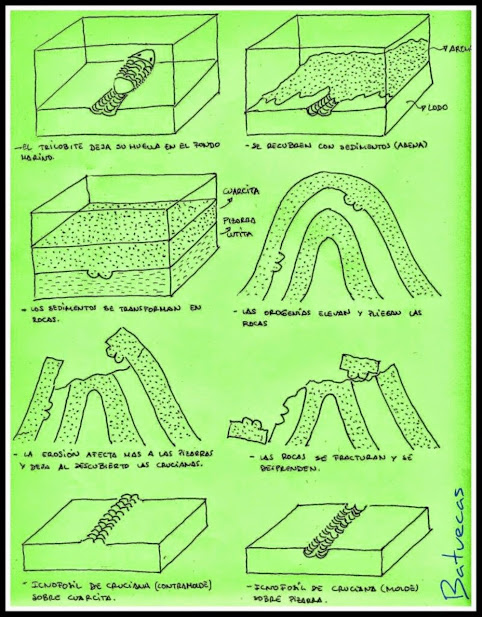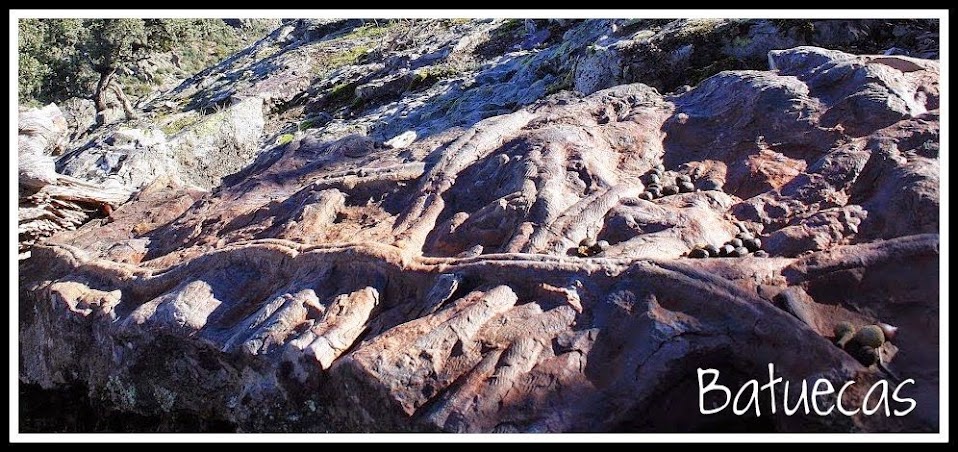Icnofósil: Cruziana. EarthCache
-
Difficulty:
-

-
Terrain:
-

Size:  (other)
(other)
Please note Use of geocaching.com services is subject to the terms and conditions
in our disclaimer.

Los fósiles ( del latín fossilis, lo que se extrae de la tierra) son los restos o señales de la actividad de organismos pretéritos. Dichos restos, conservados en las rocas sedimentarias, pueden haber sufrido transformaciones en su composición (por diagénesis) o deformaciones (por metamorfismo dinámico) más o menos intensas. La ciencia que se ocupa del estudio de los fósiles es la paleontología.

Los icnofósiles o icnitas, del griego ikhnos, significa huella o marca. Son las estructuras preservadas en rocas sedimentarias que registran actividad biológica. Aunque no suelen presentar la espectacularidad de otros tipos de fósiles, ofrecen a veces información más importante sobre los organismos, ya que nos muestran su relación con el entorno.

Una cruziana es la huella (icnofósil), que dejó en el fondo oceánico de la era paleozoica (entre 542 y 251 millones de años) un bicho, artrópodo, que podría parecerse a un ciempiés marino llamado trilobites. Los fósiles dejan siempre dos huellas, una es el molde, es decir la huella en sí, y la otra es el contramolde, es decir, la roca que rellenó la huella. Las cruzianas se suelen conservar como contramolde.

Crucianas de la Sierra de Francia:
Predominan los sedimentos paleozoicos del ordovícico inferior (cuarcitas y cuarcita armoricana), que se formaron en la plataforma marina poco profunda del continente Gondwana. Todo este material fue deformado por la orogenia hércinica en el carbonífero inferior y luego se hizo añicos en tiempos más cercanos. Es decir la cuarcita, era arena de un lecho marino poco profundo de hace más de 400 millones de años, que con el peso de los sedimentos se transformó en roca. Estábamos casi en el polo sur, y no había vida fuera del mar, los trilobites eran los animales mas numerosos, y prueba de ello son las cruzianas, que son las huellas que dejaban a su paso en el lecho marino.

El cache no es como el resto de los caches, aquí no hay una caja que encontrar y logear. En cambio tendrás que responder a una serie de preguntas, cuyas respuestas me mandarás por email. Cuando recibas mi confirmación por email, entonces podrás poner un "Found it", puedes adjuntar una foto del lugar de las coordenadas, para demostrar que has estado allí, esto último no es obligatorio, pero así evitamos falsos "found it".
A) En las coordenadas encontrarás una fuente, ¿Cuántas rocas con restos de cruzianas hay en la fuente?.
B) ¿Son moldes o contramoldes?.
C) Si vieras estas cruzianas por primera vez, y no supieras que son, ¿Qué pensarías que podrían ser?.

Fossils (from Latin fossilis, which is extracted from the earth) are the remains or signs of bygone organisms activity. These remains, preserved in sedimentary rocks may have undergone changes in its composition (diagenesis) or deformation (dynamic metamorphism) of more or less intensity. The Paleontology are the science that studies fossils.
Trace fossils, from Greek ikhnos, it means mark or trace. Structures are preserved in sedimentary rocks that they are record biological activity.
Although they not usually have the spectacle of other fossils, sometimes they offer important information on organisms, as they show us their relationship with the environment.
A cruzian is a trace fossils, left on the ocean floor of the Paleozoic era (between 542 and 251 million years ago) an arthropod, which could resemble a marine centipede called trilobites. Fossil footprints left two trace fossils, one is the mould, and the other is the countermould, that is, the rock that filled the footprint. The Cruzians are often countermould.
Cruzians in the "Sierra de Francia":
Ordovician Paleozoic sediments are abundant (quartzites and Armorican quartzite), which formed in shallow marine platform of Gondwana. All this material was deformed by the Variscan orogeny in the lower Carboniferous and then it shattered in more recent times. Quartzite was sand in a shallow seabed over 400 million years ago, with the weight of more sediment is transformed into rock. We were almost at the south pole, and there was no life out of the sea, animals trilobites were more numerous, and the proof is the Cruzian, which are the traces left in their wake on the sea bed.
The cache is not like the rest of the caches, here there is not a box to find and logear. Instead you have to answer a series of questions, that you must send me by email. When you will receive my confirmation by email, then you could put a "Found it", you can attach a photo of the location coordinates to prove you've been there.
A) How many rocks with cruzianas there are in the fountain (coordinate's place)?.
B) Is it mould or countermould?.
C) If you saw these cruzianas for the first time, and do you not know who they are, what would you think that it might be?
Additional Hints
(No hints available.)